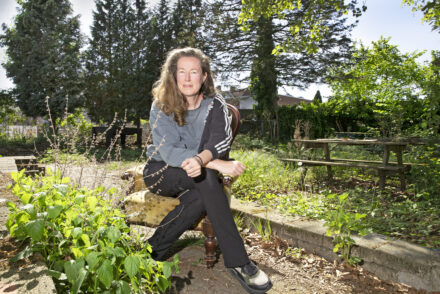Tineke Snijders: ‘If it were possible, I would immediately acquire new research techniques’
Every month, Univers asks a scientist what they would research if everything were possible. Enough money, enough time, no restrictions. In short: utopian thinking. Associate Professor Tineke Snijders (TSB) kicks off the column.

What are you currently working on?
‘I have spent the past few years researching language development in the brain. We use a device, a sort of cap (EEG), which we place on the heads of young children and babies. Through sensors, we measure the electrical activity in the brain. For instance, we investigate the importance of the brain being able to follow the rhythm of speech – the brain, as it were, adopts the rhythm of the language. An interesting question is: what does this mean for further language development?’
Do brains have a sense of rhythm?
‘Yes, for example, babies need to learn where word boundaries are, where certain words begin and end, because it’s not like parents say: will, space, you, space, a, space, bottle. The rhythm of language can help with this. It’s about following patterns of stress and syllables. We’re curious: can eight-month-old babies who can follow that stressed rhythm well extract words from continuous speech more effectively later on? And does their language develop faster than that of children whose brains are less adept at following this rhythm?’
‘We are also examining how visual information, like mouth movements, helps with processing speech. This provides an extra cue for following that rhythm, namely the mouth opening and closing.’
You’ve previously received a Veni grant, and recently a Vidi. Is it difficult for you to think even bigger?
‘Well, I do have a substantial grant, but on the other hand, you can only run a few projects with it. And with child and baby research, you’re somewhat limited in what you can do. It’s hard to keep a baby happy for long. After fifteen minutes, it’s usually over. And you’ve only tested a little.’
Before we continue: what does your data collection look like with these little participants?
‘Parents come here with their baby. We explain roughly what we’ll be doing and then put the cap on the baby. We need to make sure the sensors make good contact. This process has to be smooth and quick; otherwise, we waste valuable research time during which we could actually measure data.’
‘Next, we place the baby – on the parent’s lap – in front of a computer screen and show a simple moving video to keep them calm. Meanwhile, we play audio fragments. Often, a student assistant is also present to distract the baby if necessary, for instance, with soap bubbles. This usually works for about ten to twenty minutes.’
‘Sometimes we do audiovisual work. The babies watch a video of someone telling a story, so they can also see the speaker’s mouth. That’s a more challenging experiment because it’s important that the participants actually keep looking at the screen.’
So the limitations of your research are not so much about time and money but more about what the participants can handle.
‘An adult can, of course, sit still. If you ask them not to blink their eyes too much because it disturbs the signal, they can comply. Babies often produce noisy data, and it’s a challenge to extract the relevant brain activity from it.’
So if you could think utopically…
‘Then the babies would be much easier to measure, haha! We could, for example, follow brain activity for much longer periods at a time. And at various points in their development.’
‘Building on that, it would also be fascinating to record everything a child hears in terms of language input. This would reveal much more about the interaction between the input they receive and brain development. In practice, this is difficult: privacy concerns mean you can’t endlessly record everything.
It would be great if this could be circumvented, for instance, with a system – something that’s already being developed – that automatically extracts all linguistic expressions without capturing the specific content of what’s being said. That way, you still safeguard privacy.’
‘Money also plays a role. We could always use more researchers to further analyze and interpret all the data we have. And there are new techniques being developed. Right now, for example, there’s a device that allows you to measure magnetic signals in children’s brains, making it possible to pinpoint where certain brain activity is located. If I could, I’d purchase that technology immediately.’
What fascinates you most about your research?
‘It’s still so unknown what exactly happens in the brain during language learning. We have a rough idea of where certain processes occur in the brain, but the underlying cellular processes are still a mystery. It’s an uncharted territory, and I don’t know if we’ll ever fully understand it. But that’s precisely what excites me. I want to know everything about it.’






